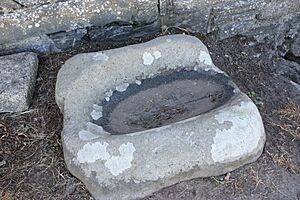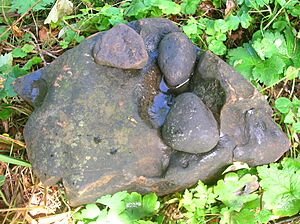Bullaun facts for kids
- For the village in Ireland see, Bullaun, County Galway
A bullaun (pronounced bull-awn) is a special hollow or dip found in a stone, often filled with water. The word comes from an old Irish word meaning "bowl." These hollows can be small or large, and sometimes you find many of them on the same rock. You might even see natural rounded stones or pebbles sitting inside them.
Contents
What are Bullaun Stones?
Bullauns are basically bowl-shaped holes carved or worn into rocks. They can be found as single holes or in groups on one large stone. Their size can vary a lot, from small cups to much larger basins. While some bullauns were clearly made by people, others might have formed naturally over time due to things like rain and erosion.
Mysterious Uses and Beliefs
For a long time, people have believed that bullaun stones have special powers. Local stories often say that the rainwater collected in these hollows can heal illnesses. This belief was so strong that people continued to use some bullaun stones even after Christianity arrived. Many bullauns are found near old churches, showing their importance.
For example, the 'Deer' Stone at Glendalough, County Wicklow, is a famous bullaun. Another one, St Brigit's Stone in County Cavan, still has its 'cure' or 'curse' stones. People would turn these smaller stones while saying prayers for healing or even to wish bad luck on someone. In 2012, a "cursing stone" was found on the Scottish island of Canna, dating back to around 800 AD. Another was found earlier on the Shiant Islands.
There's also a story about St. Aid, a bishop from the 6th century. It's said that when he was born, his head hit a stone, leaving a hole. Rainwater collected in this hole and could cure all sicknesses, linking it to the Irish bullaun tradition.
Bullauns Around the World
Bullauns aren't just found in Ireland and Scotland. You can also see them in other countries like Sweden (especially on the island of Gotland), Lithuania, and France. In Cornwall, England, 'King Arthur's footprint' at Tintagel Castle is another circular hollow. It was once thought to be part of old kingship ceremonies. These bullauns might have started as natural holes made by rain, but people likely made them bigger or used them for special purposes. They are similar to 'cup-marked stones' found across Europe, suggesting they have been important since ancient times.
Bullauns in Cornwall, UK
In Cornwall, UK, several bullauns can be found on Rosewall Hill, near St Ives. They are often on top of or close to the highest points of granite rocks. It's a bit of a mystery whether these are entirely man-made or if nature helped create them. Many granite boulders on this hill have natural hollows that look like bullauns forming. However, the fact that the larger ones are on high points suggests that these spots were chosen for their significance. Just north of Rosewall Hill, on Trevalgan Hill, there's a round bullaun about 50 cm across.
Images for kids
-
Bullaun in Tramore, Ireland









